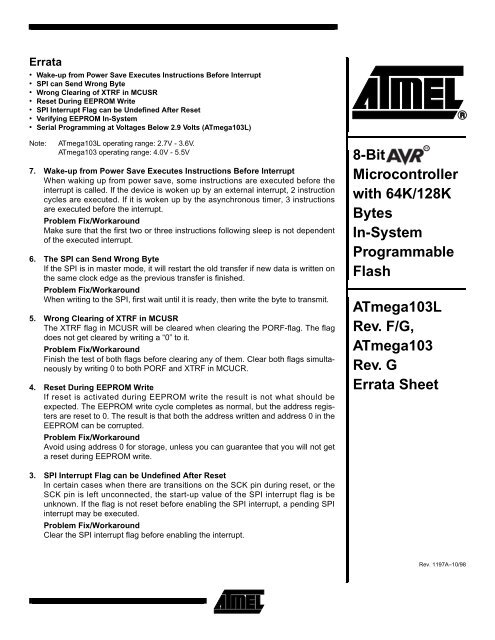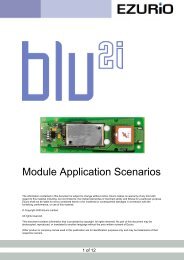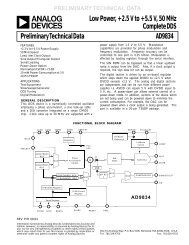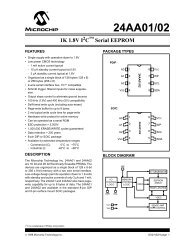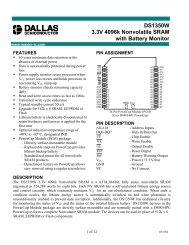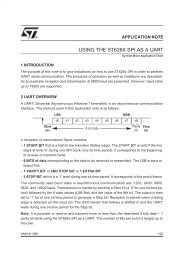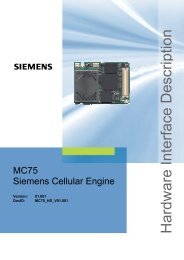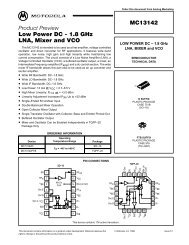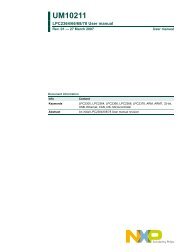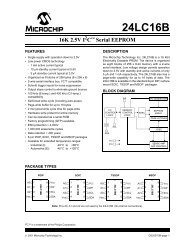ATmega 103L Rev. F/G, ATmega 103 Rev. G Errata Sheet 8-Bit AVR ...
ATmega 103L Rev. F/G, ATmega 103 Rev. G Errata Sheet 8-Bit AVR ...
ATmega 103L Rev. F/G, ATmega 103 Rev. G Errata Sheet 8-Bit AVR ...
- No tags were found...
Create successful ePaper yourself
Turn your PDF publications into a flip-book with our unique Google optimized e-Paper software.
<strong>Errata</strong>• Wake-up from Power Save Executes Instructions Before Interrupt• SPI can Send Wrong Byte• Wrong Clearing of XTRF in MCUSR• Reset During EEPROM Write• SPI Interrupt Flag can be Undefined After Reset• Verifying EEPROM In-System• Serial Programming at Voltages Below 2.9 Volts (<strong>ATmega</strong><strong><strong>103</strong>L</strong>)Note:<strong>ATmega</strong><strong><strong>103</strong>L</strong> operating range: 2.7V - 3.6V.<strong>ATmega</strong><strong>103</strong> operating range: 4.0V - 5.5V7. Wake-up from Power Save Executes Instructions Before InterruptWhen waking up from power save, some instructions are executed before theinterrupt is called. If the device is woken up by an external interrupt, 2 instructioncycles are executed. If it is woken up by the asynchronous timer, 3 instructionsare executed before the interrupt.Problem Fix/WorkaroundMake sure that the first two or three instructions following sleep is not dependentof the executed interrupt.6. The SPI can Send Wrong ByteIf the SPI is in master mode, it will restart the old transfer if new data is written onthe same clock edge as the previous transfer is finished.Problem Fix/WorkaroundWhen writing to the SPI, first wait until it is ready, then write the byte to transmit.5. Wrong Clearing of XTRF in MCUSRThe XTRF flag in MCUSR will be cleared when clearing the PORF-flag. The flagdoes not get cleared by writing a “0” to it.Problem Fix/WorkaroundFinish the test of both flags before clearing any of them. Clear both flags simultaneouslyby writing 0 to both PORF and XTRF in MCUCR.4. Reset During EEPROM WriteIf reset is activated during EEPROM write the result is not what should beexpected. The EEPROM write cycle completes as normal, but the address registersare reset to 0. The result is that both the address written and address 0 in theEEPROM can be corrupted.Problem Fix/WorkaroundAvoid using address 0 for storage, unless you can guarantee that you will not geta reset during EEPROM write.8-<strong>Bit</strong>Microcontrollerwith 64K/128KBytesIn-SystemProgrammableFlash<strong>ATmega</strong><strong><strong>103</strong>L</strong><strong>Rev</strong>. F/G,<strong>ATmega</strong><strong>103</strong><strong>Rev</strong>. G<strong>Errata</strong> <strong>Sheet</strong>3. SPI Interrupt Flag can be Undefined After ResetIn certain cases when there are transitions on the SCK pin during reset, or theSCK pin is left unconnected, the start-up value of the SPI interrupt flag is beunknown. If the flag is not reset before enabling the SPI interrupt, a pending SPIinterrupt may be executed.Problem Fix/WorkaroundClear the SPI interrupt flag before enabling the interrupt.<strong>Rev</strong>. 1197A–10/981
2. Verifying EEPROM In-SystemEEPROM verify In-System Programming mode cannotoperate with maximum clock frequency. This is independentof the SPI clock frequency.Problem Fix/WorkaroundReduce the clock speed, or avoid using the EEPROMverify feature.1. Serial Programming at Voltages Below 2.9 VoltsAt voltages below 2.9 Volts, serial programmingmight fail.Note: Applies only to <strong>ATmega</strong><strong><strong>103</strong>L</strong>.Problem Fix/WorkaroundKeep V CC above 2.9 Volts during in-system programming.2<strong>ATmega</strong><strong>103</strong>/L


